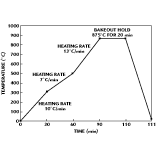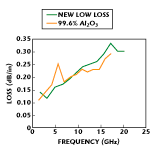A Low Loss, Lead-free LTCC System for Wireless and RF Applications
DuPont Microcircuit Materials, The DuPont Co.
Wilmington, DE
As the number and complexity of wireless applications grow, needs increase for component and interconnect technologies that allow the direct attachment of bare ICs, can be manufactured in high volumes at low cost and provide low loss at frequencies above 1 GHz as well as high thermal dissipation. The 951 Green Tape™ system has been adopted for a large number of low frequency and RF applications and meets many requirements for frequencies up to 10 GHz.
Many current and near-term applications exist in the 800 MHz to 3 GHz frequency range, including cellular telephones (800 to 900 MHz and 1.8 to 2.4 GHz), pagers (900 MHz), wireless local area networks (2.4 GHz), wireless local loop (1.5 to 3 GHz), Global Positioning Systems (1.2 to 1.6 GHz) and PCS applications (1.8 to 2 GHz). While a number of military and avionic applications exist in the 3 to 15 GHz range, the moderate-volume commercial applications of interest include earth-to-satellite (6 to 14 GHz) and satellite-to-earth (4 and 12 GHz) communication systems. Automotive collision-avoidance systems operate at even higher frequencies (35 and 77 GHz), although volume commercial use has yet to take place. For many of these applications, 951 Green Tape is a good alternative to FR-4 printed wiring boards (PWB).
To fill the need for circuit materials in higher frequency ranges, a new lower loss, low temperature cofired ceramic (LTCC) system is required. The system must retain the desirable features of the current 951 Green Tape system such as high strength, reliable shrinkage control, compatibility with both silver and gold metallizations, and ease of processing both in tape handling and short-cycle firing profile. Features that lead to high loss in a ceramic were studied in 951 Green Tape to achieve this development and a new low loss system was designed.
Low loss at high temperatures is achieved by developing new proprietary glass chemistries with controlled crystallization and alumina filler with controlled particle size and morphology. Low glass-softening temperature allows low firing temperature and broad processing latitude. The system provides a cost-effective choice for component fabrication and interconnects for RF applications. This article focuses on ceramic materials development, metal compatibility and electrical properties of this new low loss system.
Tape Development
The 951 tape consists of a glass and alumina filler. This combination was maintained for the development of new ceramic systems because it provides high fracture strength. Glasses were designed to provide lower loss than the glass in 951 tape while maintaining compatibility with the alumina filler. Lead was not used for environmental reasons since the large Pb+2 ion may contribute to high loss. Low loss correlates with small, tightly bound ions such as Si+4 in SiO2 .2 Glasses that crystallize on firing have been reported to exhibit low loss.3
Small, tightly bound B+3 was used as the primary framework component. Glasses were designed to crystallize by partial reaction with the alumina filler to form CaAl2B2O7 and LaBO3 . A low melting temperature was maintained to  permit silver compatibility. The firing profile is 1.5 hours to a 875°C, 20-minute peak. Cool-down time is not critical. Figure 2 shows the firing profile. Figure 3 shows a scanning electron microscope image of the polished ceramic, revealing the high density achieved
permit silver compatibility. The firing profile is 1.5 hours to a 875°C, 20-minute peak. Cool-down time is not critical. Figure 2 shows the firing profile. Figure 3 shows a scanning electron microscope image of the polished ceramic, revealing the high density achieved  and crystalline regions. Coupled with x-ray diffraction, the white regions, needle-like crystals and large darker areas are identified as LaBO3 , CaAl2 B2 O7 and the alumina filler, respectively.
and crystalline regions. Coupled with x-ray diffraction, the white regions, needle-like crystals and large darker areas are identified as LaBO3 , CaAl2 B2 O7 and the alumina filler, respectively.
The tape is designed with the same organic ingredients as 951 Green Tape and, therefore, is cut, printed, laminated and fired in the same manner. It is important to have a low coefficient of thermal expansion (CTE) and a close match to Si or GaAs. The ceramic exhibits a CTE of 5.3 ppm/°C, dielectric constant at 1 MHz of 6.5 and dissipation factor of 0.1 percent. Table 1 lists the material’s fired properties.
|
Table I | |
|
Shrinkage, x, y (%) |
10.1 |
|
TCE (ppm/ ° C) |
5.3 |
|
Fracture Strength (MPa) |
208 |
|
Surface Smoothness ( m m) |
0.7 |
|
Dielectric constant at 1 MHz |
6.5 |
|
Dissipation factor |
0.1 |
The ceramic is designed to be compatible with existing gold and silver conductors, but primarily is compatible with silver conductors for commercial acceptability in high volume, cost-sensitive, portable wireless applications. No stain around cofired silver is exhibited (which is often found in cofired ceramics and indicates silver diffusion). For die attachment (particularly with large die), surface flatness is very important. The new ceramic fires flat with the DuPont type 6142D silver ground plane conductor and provides cofired solderability with the DuPont type 6146D Pd/Ag. Soldered pad adhesions are in the 20 to 25 N range. The ceramic is compatible with cofired gold DuPont type 5734 material. Wire bonding pull strengths for 2-mil wire are 42.53 g with a sigma of 3.64 g.
High Frequency Measurements
High frequency losses were measured on ring resonators. This method has the advantage of providing multiple data points.4 The ring geometry and experimental method were similar to a method described previously.5 Ring resonators were prepared by cofiring eight ceramic tape layers with silver conductors (DuPont type 6142D silver ground plane with DuPont type 6145D silver ring). Typically, the substrates were 30 mils thick and the rings measured 2.8" half-length with a conductor width of 38 mils. The coupling gap was 9 mils.
 Measurements were made using the model HP 8510C microwave network analyzer. Figure 4 shows attenuation for the new low loss LTCC tape vs. 951 Green Tape and the data reported previously for the low loss system.5 All of the products were tested with cofired silver conductors.
Measurements were made using the model HP 8510C microwave network analyzer. Figure 4 shows attenuation for the new low loss LTCC tape vs. 951 Green Tape and the data reported previously for the low loss system.5 All of the products were tested with cofired silver conductors.
The data show that the new system has lower losses than the control examples throughout the 1 to 23 GHz range. The losses are lowest in the 1 to 3 GHz commercial range. The 951 Green Tape and reference data5 show comparable attenuation in the 1 to 5 GHz range.
range.
Figure 5 shows a comparison of the attenuation of the new low loss system and that of 99.6 percent alumina. Ring resonators and ground planes of a thick-film gold conductor (DuPont type 5734) were printed and postfired on both substrates. Attenuation was approximately the same for both substrates over the range. The data compare well with those reported previously.6
Conclusion
From an understanding of the material factors governing loss, a new Green Tape system has been developed that exhibits low loss up to 23 GHz and has many of the desirable features of 951 Green Tape. The new LTCC system is equipped with many of the features required for portable wireless and RF circuit applications. The system consists of ceramic tape (based on alumina-filled glass) and compatible Ag-based internal conductors for multilayer applications. Top-surface Ag and Au conductors provide options for wire bond, flip-chip or solder attachment.
References
1. D.I. Amey and S.J. Horowitz, "Microwave Material Characterization," Proceedings of the International Symposium on Microelectronics (ISHM), 1996, pp. 494–499.
2. W.K. Kingery, H.K. Bowen and D.R. Uhlmann, "Introduction to Ceramics," Second Edition, John Wiley & Sons, 1976, p. 943.
3. J.H. Alexander, S.K. Muralidhar, G.J. Roberts and T.J. Vlach, "A Low Temperature Cofiring Tape System Based on a Crystallizing Glass," ISHM Proceedings, 1991, p. 414.
4. J. Gipprich, K. Leahey, A. Martin, E. Rich and K. Sparks, "Microwave Dielectric Constant of a Low Temperature Cofired Ceramic," Proceedings of the 41st Electronic Components and Technology Conference, 1991, pp. 20–25.
5. S. Vasudevan and A. Shaikh, "Microwave Characterization of Low Temperature Cofired Tape," Advancing Microelectronics, November/December 1995, pp. 16–24.
6. P.C. Donohue, D.I. Amey, M.A. Saltzberg and S.S. Gallo, "New Low Insertion Loss Green Tape™ System for High Frequency Applications," Proceedings of the Ceramic Society of Japan, 1994, p. 66.
DuPont Microcircuit Materials, The DuPont Co.,
Wilmington, DE
(800) 284-3382 (press #3).
